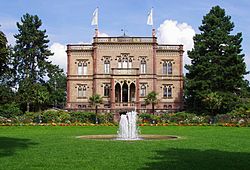Archaeological Museum Colombischlössle
 Colombischlössle (2011) |
|
| Data | |
|---|---|
| place | Freiburg im Breisgau , Germany |
| Art | |
| opening | 1938 |
| operator |
City of Freiburg
|
| management |
Beate Grimmer-Dehn
Helena Pastor Borgoñón |
| Website | |
| ISIL | DE-MUS-048611 |
The Archaeological Museum Colombischlössle of the Freiburg Municipal Museums is an archaeological museum in the neo-Gothic Villa Colombischlössle on the Rotteckring of Freiburg im Breisgau .
history
The origins of the collection go back to Alexander Ecker , Heinrich Fischer and Wilhelm Deecke . Deecke was head of the Geological Institute at the University of Freiburg . He expanded the collection of the Museum of Prehistory and Ethnography , which had existed since 1867, and from 1926 moved it to the Geological Institute at Hebelstraße 40. In order to look after this museum, Deecke called the prehistorian Georg Kraft to Freiburg. Under Kraft, the Museum of Prehistory and Protohistory was separated from the geological institute in 1936 and from then on belonged to the university's philosophical faculty as an independent institute . On this occasion it was relocated to newly designed rooms in the Adelhauser monastery . Georg Kraft was now in charge of the university's institute, the preservation of archaeological monuments and the collection called the “Museum of Prehistory”. The new museum was supported by the city administration and now also managed the city's holdings on prehistory.
In June 1938 the "Museum of Prehistory" was opened. Kraft headed the institute until his death in the bombing raid on Freiburg in 1944 . After the war, the museum was no longer open to the public due to a lack of space; the Institute for Prehistory and Protohistory, which had now been detached from the museum, and the State Preservation of Monuments, which were also separate from the museum and the institute, were now housed in the same building. In 1961, the holdings were stored by the monument preservation department, as the later nature museum was set up in the monastery building
In 1978 the local council decided to re-establish the Museum of Prehistory and Early History in the Colombischlössle, and in 1979 planning began. In 1983 the museum was reopened by Lothar Späth .
exhibition
The permanent exhibition shows archaeological finds from the Paleolithic to the Middle Ages . The finds include a large number of permanent loans from the state of Baden-Württemberg.
The exhibition includes, for example, the unique, 10,000-year-old Gagat figurines of the Ice Age hunters and gatherers from Petersfels . Furthermore, are legacies of the oldest farmers in high- and upper Rhine presented and testimonies of the metal production from the Bronze Age. The oldest glass bowl north of the Alps and the Celtic grand grave of Kappel-Grafenhausen can also be seen. The Roman rooms on the first floor, redesigned in 2009, illustrate the topics of technology, the military and everyday life with numerous finds, including from the Roman camp in Dangstetten and the Altenburg oppidum, with memorable texts and interactive stations. Runic script documents such as the Neudingen rune staff from the 6th century and the Alemannic treasury with finds from richly furnished graves from the early Middle Ages in the basement round off the repertoire of the Archaeological Museum. Models, interactive stations and numerous events illustrate the special features and living conditions of each epoch.
The museum offers educational activities for school classes, families and children , where they can try out for themselves how fires were made in the Stone Age or Roman oil lamps were made. The house maintains a reference library for specialist archaeological publications.
The museum regularly shows special exhibitions on changing topics, such as When the mammoth started to sweat ... A children's exhibition on the Stone Age from March 21, 2013 to February 23, 2014. In the summer of 2014, the house was renovated.
management
The museum in the Colombischlössle was set up by Gerd Biegel and managed until 1986, followed by Hilde Hiller until 2004. Under her leadership, the Stone and Bronze Age department was re-established in 1995, after which the Iron Age / Celts department was revised until 1997. These two departments were followed by the Alemannenschatzkammer in 2000, with the Early Middle Ages department under Hilde Hiller. Her successor was Helena Pastor Borgoñón, whose focus is on Roman times. Since 2012 she has shared the role of director with Beate Grimmer-Dehn.
literature
- Hilde Hiller: 20 years of the museum for prehistory and early history in the Colombischlössle. Museum of Pre- and Protohistory, Freiburg, (Breisgau) 2003.
- Beate Grimmer-Dehn, Kathrin Lieb, Hans Oelze, Helena Pastor, Angelika Zinsmaier: City - Country - Museum. A unique cooperation in the Freiburg Colombischlössle. In: Martin Kemkes et al. (Ed.): Ob res prospere gestas. Because of successfully executed deeds. Festschrift for Jörg Heiligmann. Likias, Friedberg 2018, ISBN 978-3-9817006-8-8 , pp. 28-35.
Web links
- Literature from and about Archaeological Museum Colombischlössle in the catalog of the German National Library
- Archaeological Museum Colombischlößle
Individual evidence
- ↑ A Brief History of Prehistoric and Protohistoric Archeology at the University of Freiburg , accessed on March 24, 2013.
- ↑ Freiburg Museum celebrates birthday , Volker Bauermeister, Badische Zeitung November 27, 2008, accessed March 24, 2013
- ↑ Children's exhibition on the Stone Age: Only the dinosaur stays outside , Stefan Tolksdorf, Badische Zeitung March 21, 2013, accessed March 24, 2013
- ↑ Freiburg: JUST SAY: "For me it was a borderline experience" - badische-zeitung.de. Retrieved February 1, 2014 .
- ^ Freiburg: Interview: Archaeological Museum Colombischlössle looks back on 30 years - badische-zeitung.de. Retrieved February 1, 2014 .
Coordinates: 47 ° 59 ′ 52 ″ N , 7 ° 50 ′ 46 ″ E